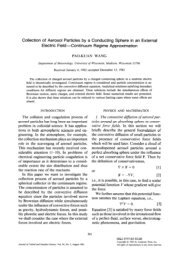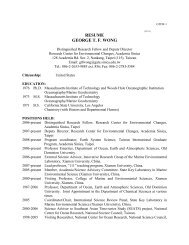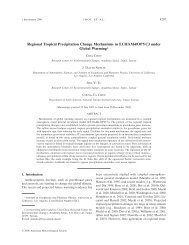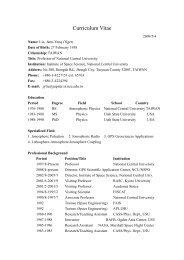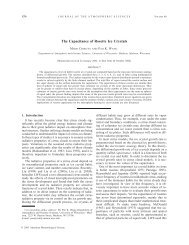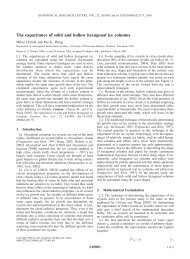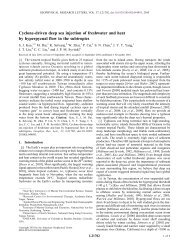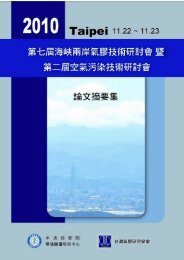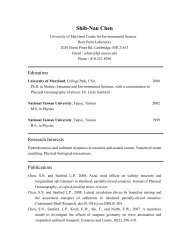1004 JOURNAL OF THE ATMOSPHERIC SCIENCESVOLUME 57TABLE 1. <strong>Reynolds</strong> numbers, dimensions, and capacitance <strong>of</strong> columnarice crystals in the present study. The quantities are dimensionless.N Re Radius (m) Length (m) Capacitance0.20.50.71.02.05.010.020.023.532.736.641.553.477.2106.7146.467.193.3112.6138.3237.4514.9106724401.36281.36281.40541.45351.65112.01512.50673.3959TABLE 3. <strong>Reynolds</strong> numbers and dimensions <strong>of</strong> broad-branch icecrystals in the present study.N Re Radius (m) Thickness (m)1.02.010.020.035.060.090.0120.0100.0125.0350.0500.0750.01000.01250.01550.015.018.032.040.050.060.065.073.0circular symmetry but r<strong>at</strong>her is a function <strong>of</strong> the azimuthalangle. The asymmetry is most easily shown bythe shape <strong>of</strong> the collision cross section A formed byconnecting y c ’s <strong>of</strong> all angles. Figures 3, 4, and 5 showexamples <strong>of</strong> these collision cross sections for droplets<strong>of</strong> various sizes colliding with the three types <strong>of</strong> icecrystals. It is immedi<strong>at</strong>ely clear th<strong>at</strong> the shapes <strong>of</strong> theA’s are more or less similar to the ice crystal crosssections themselves. When droplets are small, their collisioncross sections (and hence the collision efficiencies)are usually (but not always) smaller. As the dropletsbecome larger, the collision cross sections becomelarger and the shapes are closer to the cross sections <strong>of</strong>the ice crystals. This behavior is obviously because <strong>of</strong>the inertia <strong>of</strong> the droplet rel<strong>at</strong>ive the strength <strong>of</strong> thehydrodynamic drag force, a reasoning th<strong>at</strong> has been discussedin gre<strong>at</strong> detail by Pruppacher and Klett (1997).When droplets are small, their inertias are small comparedto the drag and their trajectories are close to thestreamlines <strong>of</strong> the flow fields, which are generallycurved around the crystal. Thus the shape <strong>of</strong> the collisioncross section would be different from the crystal.When droplets are larger, their inertia becomes gre<strong>at</strong>erand their trajectories are straighter; hence, the collisioncross sections have shapes closer to th<strong>at</strong> <strong>of</strong> the crystal.efficiency is very small when the droplet is small dueto its small inertia, as explained previously. In the cases<strong>of</strong> Re 1.0 and 2.0, the efficiency drops to very smallvalue (10 4 ) for droplets with radii less than 9 m.For higher-Re (larger ice crystals) cases, this efficiencydrop is more gradual and there is no sharp cut<strong>of</strong>f. Thisis in contrast with earlier studies where a cut<strong>of</strong>f <strong>at</strong> a 2 5 m occurs (e.g., Pitter and Pruppacher 1974; Pitter1977). Instead, the efficiency remains finite even fordroplets as small as 2.5 m, which is in good agreementwith Kajikawa’s (1974) experimental results. Recent observ<strong>at</strong>ionalstudies also confirm th<strong>at</strong> many frozen dropletson the rimed ice crystals are smaller than 5 m.The reason th<strong>at</strong> some previous field observ<strong>at</strong>ions indic<strong>at</strong>edthe scarcity <strong>of</strong> frozen droplets with a radius lessthan 5 m on planar ice crystals (e.g., Harimaya 1975;Wilkins and Auer 1970; Kikuchi and Ueda 1979; andD’Enrico and Auer 1978) is probably due to the locala. Hexagonal pl<strong>at</strong>esFigures 6, 7, and 8 show the computed collision efficienciesfor the three crystal habits. The case <strong>of</strong> hexagonalice pl<strong>at</strong>es is shown in Fig. 6. The general fe<strong>at</strong>urehere is th<strong>at</strong>, <strong>at</strong> a fixed crystal <strong>Reynolds</strong> number, theTABLE 2. <strong>Reynolds</strong> numbers, dimensions, and capacitance <strong>of</strong> hexagonalice pl<strong>at</strong>es in the present study. The quantities are dimensionless.N Re Radius (m) Thickness (m) Capacitance1.02.010.020.035.060.090.0120.080.0113.3253.3358.2473.8620.0750.0850.018.020.032.037.041.045.048.049.00.72980.69770.66390.64850.63710.62780.62210.6179FIG. 2. Trajectories <strong>of</strong> a droplet <strong>of</strong> 2 m in radius moving in thevicinity <strong>of</strong> a falling broad-branch ice crystal <strong>at</strong> Re 10. Trajectories1, 2, 6, 7, and 8 are misses, and trajectories 3, 4, 5 are hits.
15 APRIL 2000 WANG AND JI1005FIG. 3. Shape <strong>of</strong> collision cross sections for a hexagonal ice pl<strong>at</strong>e<strong>at</strong> Re 20, colliding with supercooled droplets <strong>of</strong> radius r. The fixedhexagon is the cross section <strong>of</strong> the ice pl<strong>at</strong>e: (a) r 3 m, (b) r 5 m, (c) r 11 m, and (d) r 27 m.microstructure <strong>of</strong> clouds instead <strong>of</strong> intrinsic collisionmechanism (Pruppacher and Klett 1997).As the drop size increases, the efficiency increasesrapidly. The efficiency reaches a peak or a pl<strong>at</strong>eau, dependingon the <strong>Reynolds</strong> number <strong>of</strong> the ice crystal, andthen drops <strong>of</strong>f sharply for further increasing drop size.The drop <strong>of</strong>f <strong>of</strong> efficiency is apparently due to the increasingterminal velocity <strong>of</strong> the droplet. When the collectorice crystal and the droplet have about the samevelocity, collision is nearly impossible and the efficiencybecomes very small (Pitter and Pruppacher 1974; Pitter1977; Martin et al. 1981; Pruppacher and Klett 1997).The efficiency maxima take the shape <strong>of</strong> peaks in smaller-Recases but become broader pl<strong>at</strong>eaus as the ice crystalRe increases, apparently because the larger crystalscan collide with droplets <strong>of</strong> broader size range and maintainfairly high efficiencies. Due to their sizes, smallercrystals are quickly ‘‘outrun’’ by droplets as dropletsbecome larger and hence are unable to perform the collision.FIG. 4. Same as Fig. 3 except for a broad-branch crystal <strong>at</strong> Re 35: (a) r 5 m, (b) r 9 m, (c) r 15 m, and (d) r 36m.The collision efficiencies <strong>of</strong> broad-branch crystals arein general smaller than those <strong>of</strong> hexagonal pl<strong>at</strong>es <strong>at</strong> thesame <strong>Reynolds</strong> number. The maximum efficiencies inthe pl<strong>at</strong>eau region are about 0.9, unlike the case <strong>of</strong> hexagonalpl<strong>at</strong>es, whose maximum efficiencies are near 1.0.This is probably due to the more open structure <strong>of</strong> abroad-branch crystal th<strong>at</strong> would allow the droplet to‘‘slip through’’ the gap between branches. The width <strong>of</strong>the ‘‘pl<strong>at</strong>eau’’ is also much narrower than the corre-b. Broad-branch crystalsFigure 7 shows the collision efficiency for broadbranchcrystals colliding with supercooled droplets. Themain fe<strong>at</strong>ures are similar to those for hexagonal pl<strong>at</strong>es.The collision efficiency for Re 1.0 is practically zero,representing an inability to rime. This cut<strong>of</strong>f <strong>of</strong> rimingability will be discussed further below.FIG. 5. Same as Fig. 3 except for a columnar ice crystal <strong>at</strong> Re 2.0: (a) r 4 m, (b) r 6 m, (c) r 35 m, and (d) r 43m.




